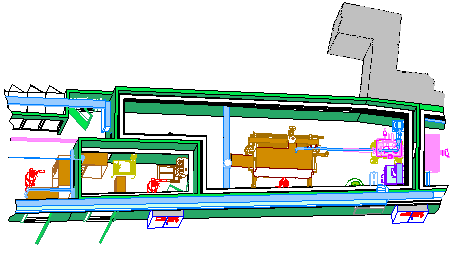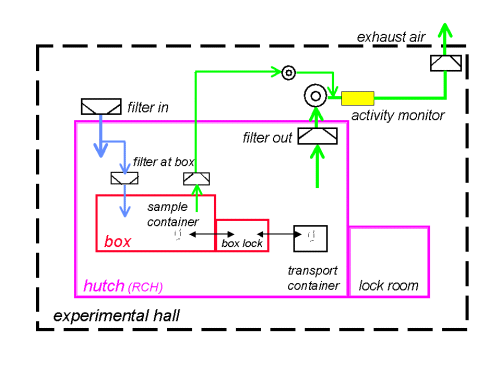RCH-1: An alpha-lab for X-ray Absorption Spectroscopy
RCH-1 is a dedicated station for X-ray absorption spectroscopy of actinoids. It has been built according to international standards for Radiochemistry laboratories, allowing to measure enclosed radioactive samples (solids, liquids or wet pastes) with an activity of up to 185 MBq (5 mCi). The hutch has a separate ventilation and air-filtering system.

Fig. 1. The RCH-1 hutch. In the center of the hutch the glove-box is shown in brown.
Possible Modes of Measurements
- XANES and EXAFS spectroscopy of radionuclides and non-radioactive samples at ambient and low temperatures
- in transmission mode for concentrated samples
- in fluorescence mode for dilute samples (> 10 ppm for EXAFS, > 1 ppm for XANES)
Equipment
- Glove box (MBraun) for handling of radioactive samples (see Fig. 2)
- Remote control of sample stages inside the glove box (up to 8 samples can be loaded)
- Optical rail for detectors
- Ionization chambers (Oxford) with variable gas mixture (electronic mass flow controllers) and pressure
- 13-element Ge solid state fluorescence detector (Canberra) with digital spectrometer (XIA-XMap) (Fig. 3)
- 4-element Si-DRIFT detector
- Closed cycle He cryostat (CryoVac)
- Fully computer-controlled operation (SPEC)
|
|
Fig. 2. Sketch of the glovebox
Fig. 3. The glovebox seen from the back, where the detectors are located (left), and from the front side, where the samples are mounted on sample holders (right).
Licensed Radionuclides
|
Nuclide
|
Max. amount /g |
Exemption /Bq |
Half-life /y |
Transport exempt. A1/A2 /Bq |
Specific activity /Bq/g |
|
|
Tc-99
|
29.1 |
5 x106 |
2.1 x105 |
4 x1013 |
9 x1011 |
6.4 x108 |
|
Po-208
|
8 x10-6 |
0 |
2.898 |
4 x1013 |
2 x1010 |
2.2 x1013 |
|
Po-209
|
3 x10-4 |
0 |
102 |
4 x1013 |
2 x1010 |
6.2 x1011 |
|
Ra-226
|
5 x10-3 |
5 x103 |
1600 |
3 x1011 |
2 x1010 |
3.7 x1010 |
|
Th-nat
|
1000 |
5 x104 |
1.4 x1010 |
no limit |
no limit |
8.2 x103 |
|
Pa-231
|
0.106 |
5 x103 |
3.28 x104 |
6 x1011 |
6 x107 |
1.7 x109 |
|
U-nat
|
1000 |
5 x106 |
4.47 x109 |
no limit |
no limit |
2.6 x104 |
|
Np-237
|
6.97 |
5 x105 |
2.1 x106 |
2 x1012 |
2 x108 |
2.6 x107 |
|
Pu-238
|
2.9 x10-4 |
5 x103 |
87.7 |
2 x1012 |
2 x108 |
6.3 x1011 |
|
Pu-239
|
0.08 |
5 x103 |
2.4 x104 |
2 x1012 |
2 x108 |
2.3 x109 |
|
Pu-240
|
0.022 |
5 x103 |
6563 |
2 x1012 |
2 x108 |
8.4 x109 |
|
Pu-241
|
4.9 x10-5 |
5 x103 |
14.35 |
4 x1013 |
1 x1010 |
3.8 x1012 |
|
Pu-242
|
1.24 |
5 x103 |
3.74 x105 |
2 x1012 |
2 x108 |
1.5 x108 |
|
Am-241
|
1.4 x10-3 |
5 x103 |
432.2 |
2 x1012 |
2 x108 |
1.3 x1011 |
|
Am-243
|
25 x10-3 |
5 x103 |
7365 |
2 x1012 |
2 x108 |
7.4 x109 |
|
Cm-244
|
6.2 x10-5 |
5 x103 |
18.1 |
4 x1012 |
4 x108 |
3.0 x1012 |
|
Cm-246
|
0.017 |
5 x103 |
4750 |
2 x1012 |
2 x108 |
1.1 x1010 |
|
Cm-248
|
1.156 |
5 x103 |
3. 39 x105 |
4 x1010 |
5 x107 |
1.6 x108 |
All radioactive samples are delivered, stored, and handled according to the safety regulations agreed upon with the ESRF. This includes sealing the samples in a multi-layer containment, permanent monitoring of radioactivity, and redundant safety systems. Only trained staff is allowed to operate this experimental station.
Safety Installation for Radioactive Work
A common multi-barrier concept is realized (Fig. 4). The samples are enclosed in an X-ray transparent container serving as the first barrier. The sample container itself is inside an additional enclosure. The glovebox is the third barrier under experiment conditions. The hutch the fourth barrier towards the experimental hall of the ESRF.
|
|
Fig. 4. Schematics of the multi-barrier concept for the safety system.
A negative pressure gradient from hall to hutch and from hutch to glovebox is maintained by an air ventilation system: it performs eight volume exchanges of air per hour. Separate ventilators for the glove box and the hutch exhaust air, each with high-absorption absolute aerosol filters, ensure an automatically regulated pressure difference of 200 Pa between the glovebox and the hutch. The exhaust air is controlled by a permanent monitoring system outside the RCH to account for radiation background effects. Before the filtered and monitored exhaust air leaves the experimental hall over the roof, another filter is inserted as an additional last barrier to the environment.



